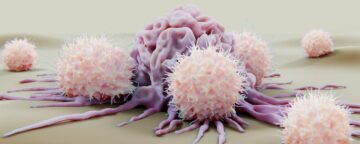Aparna Nathan in The Scientist:
 When a rogue cell starts proliferating out of control, the first responders on the scene should be the body’s own immune cells—for example, natural killer (NK) cells, which use toxic molecules to dissolve foreign cells. Ideally, proteins that are specific to cancer cells would trigger the immune cells to destroy the cancer cells, and a growing category of new NK cell therapies harness these cellular assassins to fight cancer.
When a rogue cell starts proliferating out of control, the first responders on the scene should be the body’s own immune cells—for example, natural killer (NK) cells, which use toxic molecules to dissolve foreign cells. Ideally, proteins that are specific to cancer cells would trigger the immune cells to destroy the cancer cells, and a growing category of new NK cell therapies harness these cellular assassins to fight cancer.
However, cancers have evolved creative strategies to evade these cellular sentinels. One way they do this is by turning cells that are typically cancer assassins into docile bystanders. For example, a 2017 study showed that tumors can avoid being killed by triggering the release of transforming growth factor beta (TGFb), a molecule that can turn NK cells into intermediate type 1 innate lymphoid cells (intILC1).1 This immune cell type is much less effective against tumors, which can undermine immunotherapy efforts.
“Tumors have developed these fantastic environments to survive,” said Sebastian Scheer, an immunologist at the Luxembourg Institute of Health and coauthor of the study. But that environment is not the only way for NK cells to transform into intILC1. In a new study in Cell Reports, a team at Monash University led by Scheer found that the molecule disruptor of telomeric silencing 1-like histone lysine methyltransferase (DOT1L) plays an important role in maintaining NK cell functions.2 When DOT1L levels decline, the NK cells turn into benign intILC1 even in the absence of cancer-induced TGFb.
More here.
Enjoying the content on 3QD? Help keep us going by donating now.
